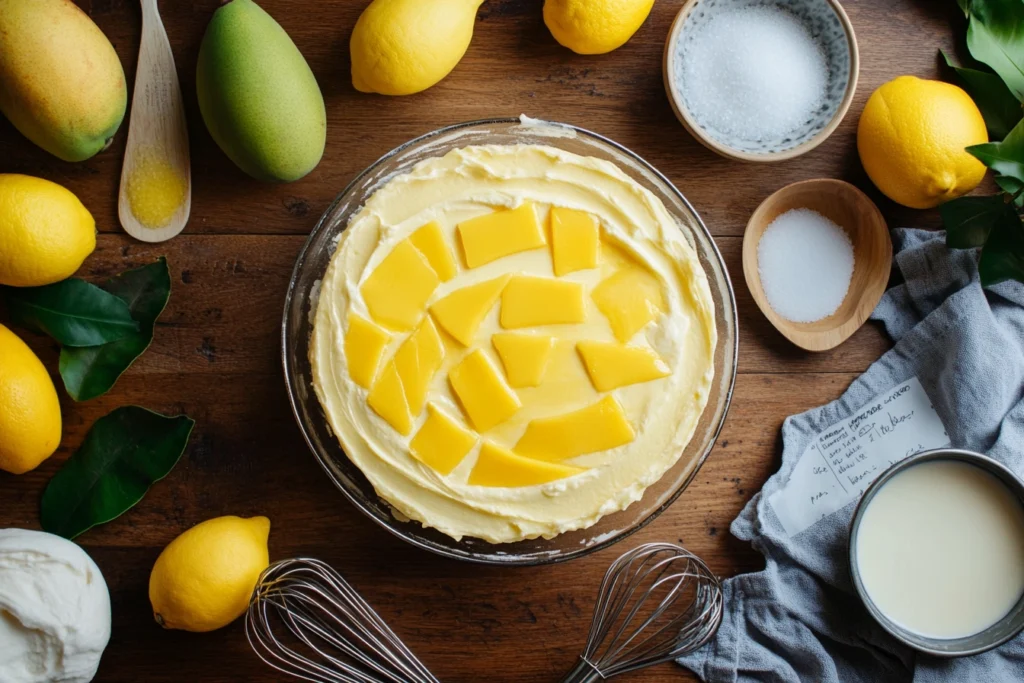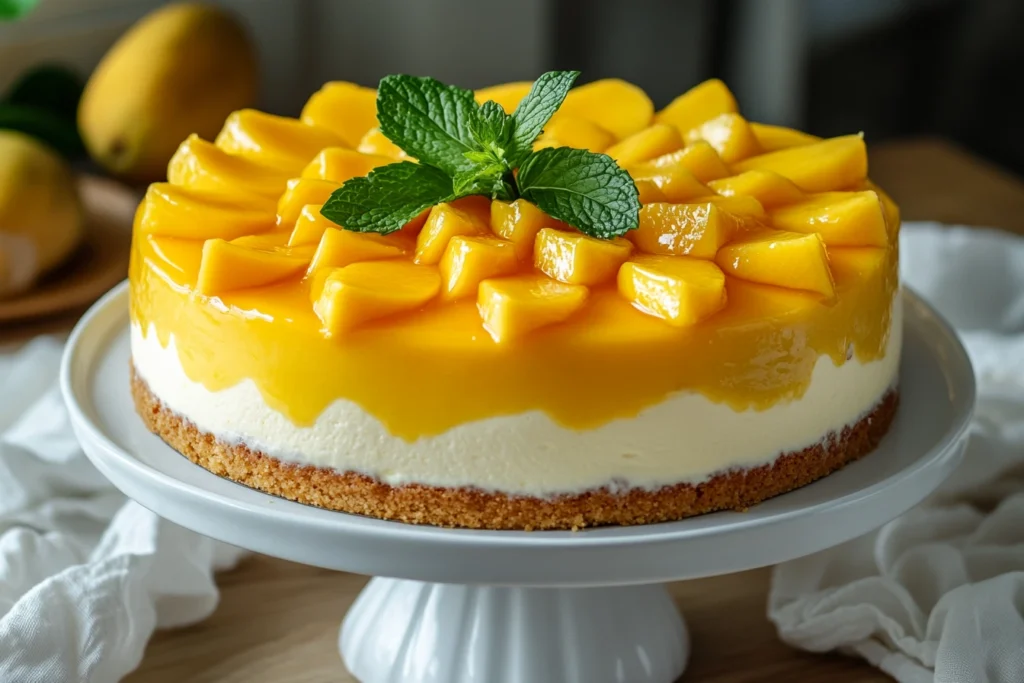Mango Mousse Cake, Mangoes have a way of transporting you—one bite and you’re on a sun-drenched beach, toes in the sand, warm breeze on your skin. Now imagine capturing that feeling in a cake. That’s exactly what this mango mousse cake does.
This dessert is a no-bake wonder that’s light, creamy, and bursting with tropical flavor. It’s the kind of cake that feels elegant but is secretly so easy to make, it almost feels like cheating. Whether you’re hosting a summer dinner party, planning a birthday surprise, or just craving something refreshing, this treat checks all the boxes.
Using fresh mangoes (or even canned in a pinch), this cake layers a silky mousse over a soft base—whether that’s sponge cake, crushed cookies, or a gluten-free nut crust, the choice is yours. And the best part? You don’t even need to turn on your oven.
What Is a Mango Mousse Cake?
A mango mousse cake is the dreamiest fusion of creamy mousse and fruity brightness layered over a soft, delicate base. Unlike a traditional baked cake, this version is all about chill-and-set simplicity, with a texture that’s airy yet indulgent.
What Makes It Special?
- The Mousse: Made from pureed mangoes, whipped cream, and gelatin (or a vegetarian alternative), the mousse is light, luscious, and naturally sweet.
- The Base: You can go classic with a sponge cake or quick and easy with a biscuit or gluten-free crust. The base provides a subtle contrast to the mousse’s cloud-like texture.
- The Glaze: A shiny mango topping gives it that picture-perfect finish—and an extra layer of tropical flavor.
This cake is versatile and forgiving, which makes it perfect for beginners and seasoned home bakers alike. Whether you’re looking for an easy no-bake mango mousse cake or a low-sugar mango mousse dessert, this version has something for everyone.
Ingredients Breakdown

This easy no-bake mango mousse cake requires just a handful of ingredients—but each one plays a key role in making the dessert light, refreshing, and irresistibly tropical. Here’s what you’ll need:
For the Base: Choose Your Style
1. Traditional Sponge Cake Base
- 3 eggs
- ½ cup sugar
- ¾ cup all-purpose flour (or gluten-free blend for a gluten-free mango mousse cake crust)
- ½ tsp baking powder
- 1 tsp vanilla extract
Note: You can also use store-bought sponge if you want to save time.
2. No-Bake Biscuit Base
- 1½ cups crushed digestive biscuits or graham crackers (gluten-free versions work beautifully!)
- 6 tbsp unsalted butter, melted
- 1 tbsp sugar (optional)
3. Nut-Based Gluten-Free Crust
- 1 cup almonds or cashews
- 6–8 soft Medjool dates
- Pinch of salt
Just blend until sticky, press into your pan, and chill—it’s a wholesome, naturally sweet crust!
For the Mango Mousse
- 2 ripe mangoes (or 1½ cups mango puree)
- 1½ cups heavy whipping cream
- 1 tbsp lemon juice (brightens the flavor)
- 2–3 tbsp sugar (adjust based on your mangoes’ sweetness; use less for a low-sugar mango mousse dessert)
- 2½ tsp powdered gelatin or 1½ tsp agar-agar for a vegetarian version
- 3 tbsp warm water (to bloom gelatin)
For the Mango Glaze (Optional, but Gorgeous!)
- ½ cup mango puree
- 1 tsp lemon juice
- 1 tsp sugar
- 1 tsp gelatin (bloomed in 1 tbsp water)
Step-by-Step Recipe Guide
Step 1: Prepare the Base
Option A – Sponge Cake Base
- Preheat oven to 350°F (175°C).
- Beat eggs and sugar together until pale and fluffy.
- Sift in the flour and baking powder. Fold gently.
- Add vanilla, mix, and pour into a lined springform pan.
- Bake 20–25 minutes until golden. Let cool completely.
Option B – No-Bake Biscuit Base
- Mix crushed biscuits with melted butter.
- Press firmly into the bottom of a springform pan.
- Chill in the fridge while you prep the mousse.
Option C – Gluten-Free Nut Crust
- Blend nuts, dates, and a pinch of salt into a sticky dough.
- Press into the base of your pan. Chill 20–30 minutes before layering mousse.
Step 2: Make the Mango Mousse
- Prepare the Mango Purée:
Peel and dice ripe mangoes, then blend until completely smooth. You should get about 1½ cups of mango purée. If you’re using canned or frozen mango, make sure it’s thawed and unsweetened. - Sweeten and Brighten:
Stir in lemon juice and sugar to the purée. Taste and adjust depending on how sweet your mangoes are. (Remember, for a low-sugar mango mousse dessert, keep the sugar minimal or use a natural sweetener like stevia or honey.) - Bloom the Gelatin:
In a small bowl, sprinkle gelatin over warm water and let it sit for 5–10 minutes to bloom. Then microwave for about 10 seconds or until fully dissolved. (If using agar-agar, follow package instructions—usually it needs to be boiled briefly.) - Combine Gelatin with Mango Purée:
Whisk the dissolved gelatin into the mango purée until well blended. Let cool slightly. - Whip the Cream:
In a chilled bowl, whip the heavy cream until soft peaks form. Be gentle—you want it fluffy, not stiff. - Fold Together:
Gently fold the mango mixture into the whipped cream in 2–3 parts. Mix just until combined, keeping the texture airy and smooth.
Step 3: Assemble the Cake
- Layer the Mousse Over the Base:
Pour the mango mousse over your prepared base (whether sponge, biscuit, or nut crust). Use a spatula to level the surface. - Chill to Set:
Refrigerate the cake for at least 4 hours, or ideally overnight, to allow the mousse to firm up. Patience pays off here!
Step 4: Prepare the Mango Glaze (Optional but Stunning!)

- Blend and Heat:
Combine mango purée, lemon juice, and sugar in a small saucepan. Heat gently over low heat. - Add Bloomed Gelatin:
Stir in bloomed gelatin until dissolved. Let the mixture cool to lukewarm. - Pour Over Set Mousse:
Once your mousse layer is fully set, gently pour the glaze on top. Swirl to even it out and refrigerate for another 30–60 minutes.
Step 5: Final Touches
- Unmold Carefully:
Run a thin knife around the edge of the pan and gently release the springform sides. - Decorate:
Top with thin mango slices, edible flowers, piped whipped cream, or a sprinkle of toasted coconut. Keep it simple or go all-out!
Tips for Success
Even though this is an easy no-bake mango mousse cake, these tips will help you nail the texture, flavor, and presentation every time:
1. Choose the Right Mangoes
Go for ripe, juicy mangoes—like Ataulfo, Alphonso, or Kent—for a rich, vibrant flavor and color. Avoid stringy varieties like Tommy Atkins if possible.
2. Taste Your Purée Before Sweetening
Mangoes vary in sweetness, so always taste your purée first. Add sugar only if it needs it—especially helpful if you’re aiming for a low-sugar mango mousse dessert.
3. Handle Gelatin with Care
Let gelatin bloom fully before heating, and avoid boiling—it can lose its setting power. If you’re using agar-agar, make sure to boil it briefly to activate it properly.
4. Whip Cream to Soft Peaks Only
For a light and airy mousse, don’t over-whip the cream. Soft peaks fold into the mango purée more easily and prevent a dense texture.
5. Chill It Long Enough
Give your cake enough chill time—at least 4 hours, preferably overnight. This ensures the mousse holds its shape when sliced. Understanding the fundamentals of classic desserts can elevate your baking skills. For instance, knowing What Is Crème Brûlée Made Of provides insights into achieving perfect custard textures, which can be applied to creating a smooth mango mousse.
Flavor Variations
This cake is a tropical blank canvas! Here are some tasty ways to tweak it:
1. Low-Sugar Delight
Swap sugar with honey, agave, or stevia. You can also skip sweeteners altogether if your mangoes are naturally sweet and ripe.
2. Vegan Version
- Use coconut cream or cashew cream in place of whipped cream.
- Use agar-agar instead of gelatin for a plant-based set.
- For a fusion of flavors, consider the Chocolate Haupia Pie, which combines coconut and chocolate in a delectable pie. Similarly, adding a chocolate layer to your mango mousse cake can introduce a new dimension of taste.
The result? A luscious, creamy mango mousse cake that’s entirely dairy- and gelatin-free.
3. Add a Second Fruit Layer
- Blend in passion fruit, pineapple, or berries with the mango purée for a tropical fusion.
- Layer with a berry compote between the base and mousse for a gorgeous flavor contrast.
- Drawing inspiration from other tropical desserts, such as haupia, a traditional Hawaiian coconut milk-based pudding, can lead to delightful variations. Incorporating coconut elements can add a rich, exotic twist to your mango mousse cake.
4. Nutty Crust Options
Try a crust made with cashews and coconut flakes, or pistachios and dates for a different spin on the gluten-free mango mousse cake crust. For those who appreciate simplicity in desserts, much like this mango mousse cake, you might enjoy our 4-Ingredient Banana Bread: Quick, Easy & Delicious Recipe. Both recipes highlight how a few quality ingredients can create delightful treats.
Serving Suggestions

This cake doesn’t just taste incredible—it’s a showstopper, too. Here’s how to serve it up in style:
1. Chilled with Tea or Wine
Serve slices cold from the fridge, paired with chamomile tea, green tea, or a light dessert wine like Moscato. The mellow flavors complement the cake’s tropical tang.
2. With a Dollop of Cream
If you’re feeling indulgent, top slices with a bit of whipped cream or a drizzle of sweetened coconut milk.
3. Party-Ready Presentation
Want to impress? Serve the mousse in individual glasses or mini cake molds for easy plating at showers, birthdays, or summer dinners.
Chef Aila’s Personal Touch
I first made a mango mousse cake on a sweltering July afternoon, when the last thing I wanted was to turn on the oven. I had ripe mangoes that needed love, a half-finished container of cream, and a memory of a mango dessert I once had in Singapore. It was light, melt-in-your-mouth, and felt like biting into sunshine.
That first version? Far from perfect. The mousse was too soft, the crust a little crumbly—but it disappeared in minutes. That was the magic. It wasn’t about precision—it was about the moment: a slice of something sweet, refreshing, and a little unexpected.
Since then, this cake has become a go-to for birthdays, brunches, and even just “because it’s Tuesday.” And every time I make it, I’m reminded that the best desserts aren’t always complicated—they’re the ones that make people smile.
Frequently Asked Questions (FAQs)
1. Can I use canned mango pulp instead of fresh mangoes?
Absolutely! Just make sure it’s pure mango pulp, not mango nectar. It’s a convenient shortcut, especially if mangoes aren’t in season.
2. How long does mango mousse cake last in the fridge?
It keeps well for up to 3–4 days if stored in an airtight container. The flavor actually deepens a little overnight.
3. Can I freeze this cake?
Yes! Once fully set, wrap it well and freeze for up to 2 weeks. Thaw in the fridge overnight before serving. Note: The texture may soften slightly after thawing.
4. Can I make it without gelatin or agar-agar?
Technically yes, but the mousse won’t set firmly. It’ll be more like a mango cream layer. For the best texture, use a gelling agent—even cornstarch can work in the glaze if you’re just skipping the mousse set.
5. Can I make it in advance for a party?
Yes, and you should! Make it a day ahead so the mousse has time to set beautifully and flavors have a chance to meld.
Final Thoughts
There’s something special about a dessert that feels elegant but doesn’t ask much of you. This mango mousse cake is just that—a tropical dream with a chill attitude. No oven. No stress. Just a few ingredients, a bit of patience, and one incredibly refreshing reward.
Whether you’re serving it up at a gathering or treating yourself to a slice on a quiet evening, this cake brings sunshine to any table. So go ahead, grab those mangoes, and make some magic. You’ve got this. 🌞🍰
